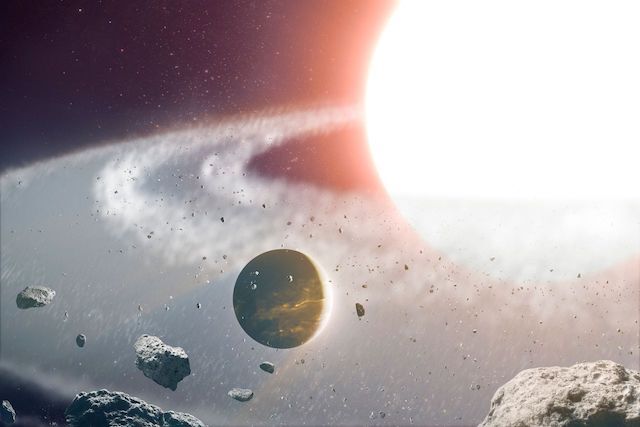For the holidays, we’re bringing you eight examples of light from real planets beyond our solar system. These real images show exoplanets light-years (aka trillions of miles) away from Earth. Exoplanets are far away, and they are millions of times dimmer than the stars they orbit. So, unsurprisingly, taking pictures of them the same way you'd take pictures of them is exceedingly hard. But new techniques and rapidly-advancing technology are making it happen.
HR 8799 – 129 light-years from Earth
Four giants twirl around their star in a slow dance over eight years of observation. Each moving dot is a gas giant planet more massive than Jupiter; the innermost planet takes 40 years to orbit its star, and the furthest takes 400 years! The wonder of seeing another star system 129 light-years away hasn’t faded since the images were first taken. The black circle in the center of the image is from a coronagraph, which purposely blocks the light of the young star to reveal the much fainter light from the planets. The HR 8799 system can be found in the constellation Pegasus.
Beta Pictoris b – 63 light-years from Earth
One of our best views of an exoplanet moving in its orbit around a distant star. Beta Pictoris b is a massive planet about 63 light-years away, orbiting the second-brightest star in the constellation Pictoris. This gas giant is about 10 times more massive than Jupiter, and passes through a bright ring of dust and debris as it circles its star. A series of images captured between November 2013 to April 2015 shows the exoplanet as it moves through 1.5 years of its 22-year orbital period. The planet is nearly 100,000 times fainter than its star; a device inside the telescope called a coronagraph blocks the light of star Beta Pictoris so the planet is visible.
51 Eridani b – 97 light-years from Earth
The bright moving spot is 51 Eridani b, the most Jupiter-like exoplanet ever imaged, about 100 light-years from Earth. A series of images taken over three years, beginning December 2014, shows a small fraction of this gas planet’s 41-year orbit around its Sun-like star. 51 Eridani b is still young enough that it glows from the heat of its birth. The striking young Jupiter hints at how our own Jupiter may have formed long ago.
HIP 65426b – 385 light-years from Earth
Hot, clouded with dust, and really, really big. The gas giant HIP 65426b, discovered using the European Southern Observatory's Very Large Telescope, is believed to be between six and 12 times the mass of Jupiter. It has a thickly clouded atmosphere and a searing temperature of 1,800 to 2,500 degrees Fahrenheit (1,000 to 1,400 degrees Celsius), and it orbits a hot, young star. Just how the planet formed is a puzzle. One possibility is that it's really a failed star, its domineering companion -- and now its host star -- preventing it from gathering sufficient mass. In this image, the starlight is blocked out so the light from its giant companion can be seen.

Webb's view of HIP 65426 b
Webb’s view of the exoplanet HIP 65426 b, also seen above, was released in September 2022. These images could give us more precise information about the gas giant's mass. It is young as planets go — about 15 to 20 million years old, compared to our 4.5-billion-year-old Earth. Astronomers discovered the planet in 2017 using ESO’s telescope in Chile, employing short infrared wavelengths of light. Webb’s view, at longer infrared wavelengths, reveals new details that ground-based telescopes would not be able to detect because of the intrinsic infrared glow of Earth’s atmosphere. Webb looked at the planet in four different wavelengths of light.
LkCa15 – 450 light-years from Earth
Like a baby photo, the brightly colored lights show infant planets in the making. There are 450 light-years between Earth and LkCa15, a young star with a doughnut-shaped protoplanetary disk around it, also known as a birthplace for planets. This composite image of the young star system LkCa15 is the first photo of several planets being formed. Protoplanetary disks form around young stars using the debris left over from the star’s formation. Though scientists don’t know for certain, it’s theorized that planets then form from this spinning disk of gas and dust around the young star. The color in this image has been added afterwards.
Gliese 504 b – 57 light-years from Earth
This celestial body is a cherry. Gliese 504 b glows pink with heat, like a dark cherry blossom in space. This giant’s star can be seen from Earth, faintly visible in the constellation Virgo, 57 light-years away. Its massive pink companion is probably a brown dwarf, an object too big to be a planet but not massive enough to burn like a star. Like planets, brown dwarfs can have atmospheres, storms, and clouds. Gliese 504 b takes 260 years to orbit its Sun-like star.
HD 106906 b – 300 light-years from Earth
The massive world HD 106906 b is one of the most distantly orbiting planets found around a Sun-like star. More than 20 times the distance than Neptune is from the Sun, this gas giant takes 3,000 years to complete one trip around its star! Its extreme separation from its parent star puzzled astronomers and challenged our idea of how solar systems form. The young world weighs in at 11 times Jupiter’s mass, and still burns with the heat of its formation. The image above was taken in thermal infrared light, where the giant planet is brightest, and processed to remove the bright light from its host star, HD 106906 A.









